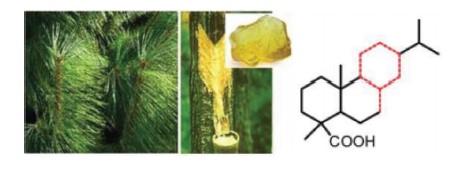In recent years, research on the use of environmentally friendly and renewable resources has increased due to the reduction of oil in the world and the damage caused to the environment by the materials obtained from petroleum.
Especially plant-derived polymers and chemicals are very useful because they are cheap, and they are abundant.
Gum rosin is a hydrocarbon rich pine tree resin with an annual production of 1.2 million tons and is one of the most abundant renewable chemicals. Gum rosin is one of the main raw materials of ink, adhesive, pharmaceutical, and varnish and gum industries [1-5].
Gum rosin is positively differentiated from other renewable chemicals because of its chemical structure. When used in combination with other polymeric structures, hydrocarbon-rich biomass of the gumrosin gives a hydrophobic effect, while the hydrophanthrene structure increases its thermal properties [3] (Figure 1.).

Figure 1. Gum rosin resin and chemical structure
The gumrosin resin usually consists of 90% acidic resin and 10% neutral substance. The resin acid is isomer with abietic acid. The rest is dehydroabietic acid and dehydroabietic acid. The glycerin ester resin is obtained from the gum rosin resin by esterification with glycerin.

Figure 2. Chemical structures of representative rosin acids [3].
In the literature, the gum rosin resin acids were reacted with different monomeric structures to give functional properties and many biodegradable and biocompatible polymeric structures were obtained.
By incorporating hydrophenanthrene structures into polymeric structures, physical and chemical properties of many petroleum-derived aliphatic and aromatic structures have been obtained [6-8].
In the R&D department of IZEL, in order to benefit from the properties provided by the gum rosin, the reactions were carried out with an alkyd containing soybean oil and the effect of gumrosin on the paint properties was determined.
The paint prepared from the gumrosin-containing alkyd showed enhanced properties such as, high gloss, faster drying time, good adhesion to metals, UV
resistance, higher gloss values and harder than the paint made from a normal alkyd resin. Our R&D department continues to work on the projects related to gum rosin resins.
 Dr. Cemil Dizman
R&D Manager
İzel Kimya
Dr. Cemil Dizman
R&D Manager
İzel Kimya
 Semiha Eral
R&D Researcher
İzel Kimya
Semiha Eral
R&D Researcher
İzel Kimya
References
[1] Jifu Wang, Preparation and Characterization of rosin-based polymeric monomer, 2011.
[2] Yao K., Degradable rosin-ester-caprolactone graft copolymers, 2011.
[3] Kejian Yao, Renewable Bio-Based Polymers and Degradable Functional Polymers, 2013.
[4] Yijun Zheng†, Well-Defined Renewable Polymers Derived from Gum Rosin, 2010.
[5] Perry Wilbon, Novel Sustainable Polymers Derived from Renewable Rosin and Fatty Acids, 2015.
[6] Olivars – Perez, A. Et al. Optical Materials, 27, 1825-1831, 2005.
[7] Fuentes-Aud’en, C. et al. Fluid Phase Equilibria, 237,117-122,2005.
[8] Louise McKeon B.Sc., Characterisation and determination of rosin compositions using analytical approaches, 2014.



 Dr. Cemil Dizman
R&D Manager
İzel Kimya
Dr. Cemil Dizman
R&D Manager
İzel Kimya
 Semiha Eral
R&D Researcher
İzel Kimya
Semiha Eral
R&D Researcher
İzel Kimya